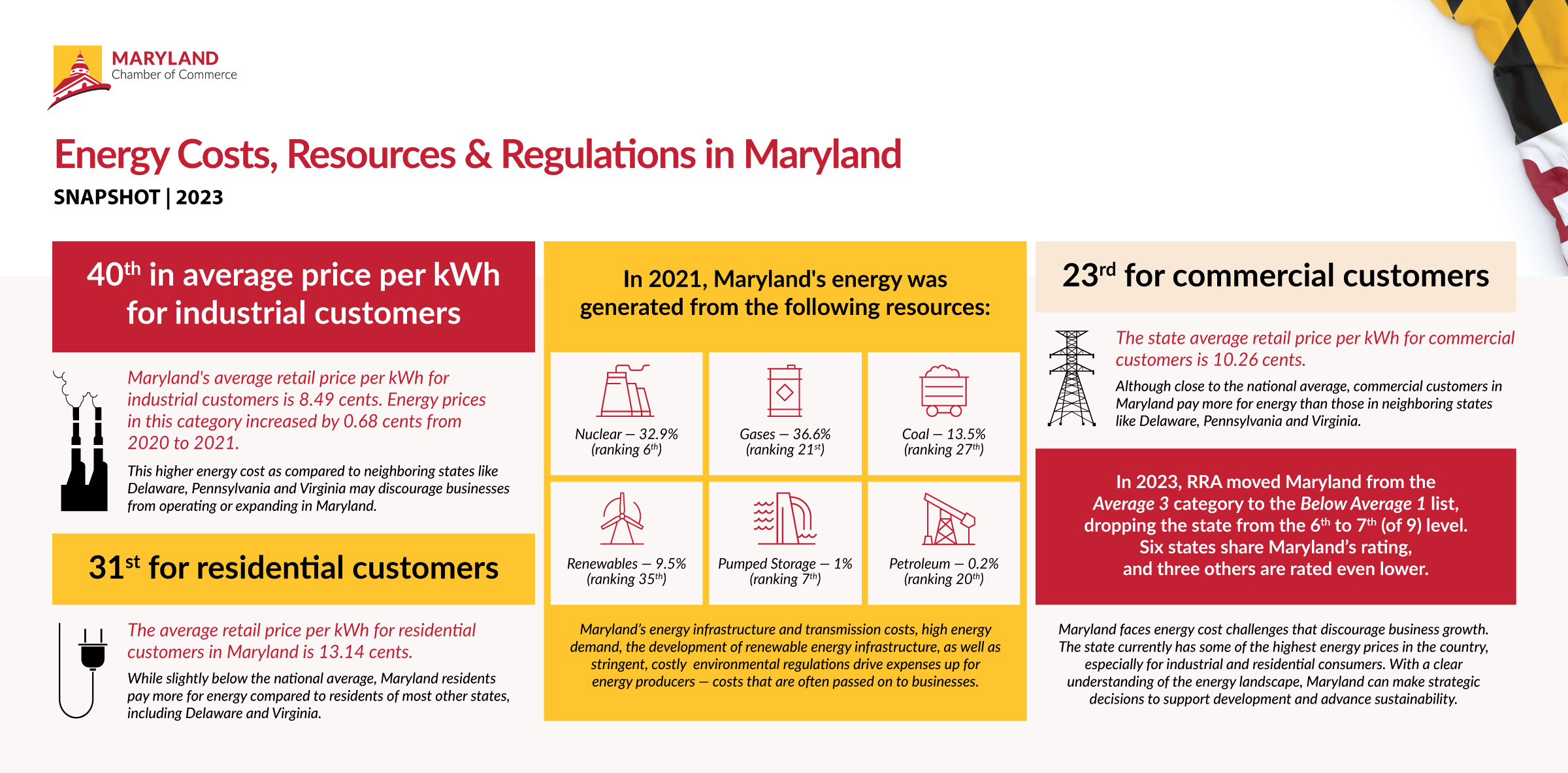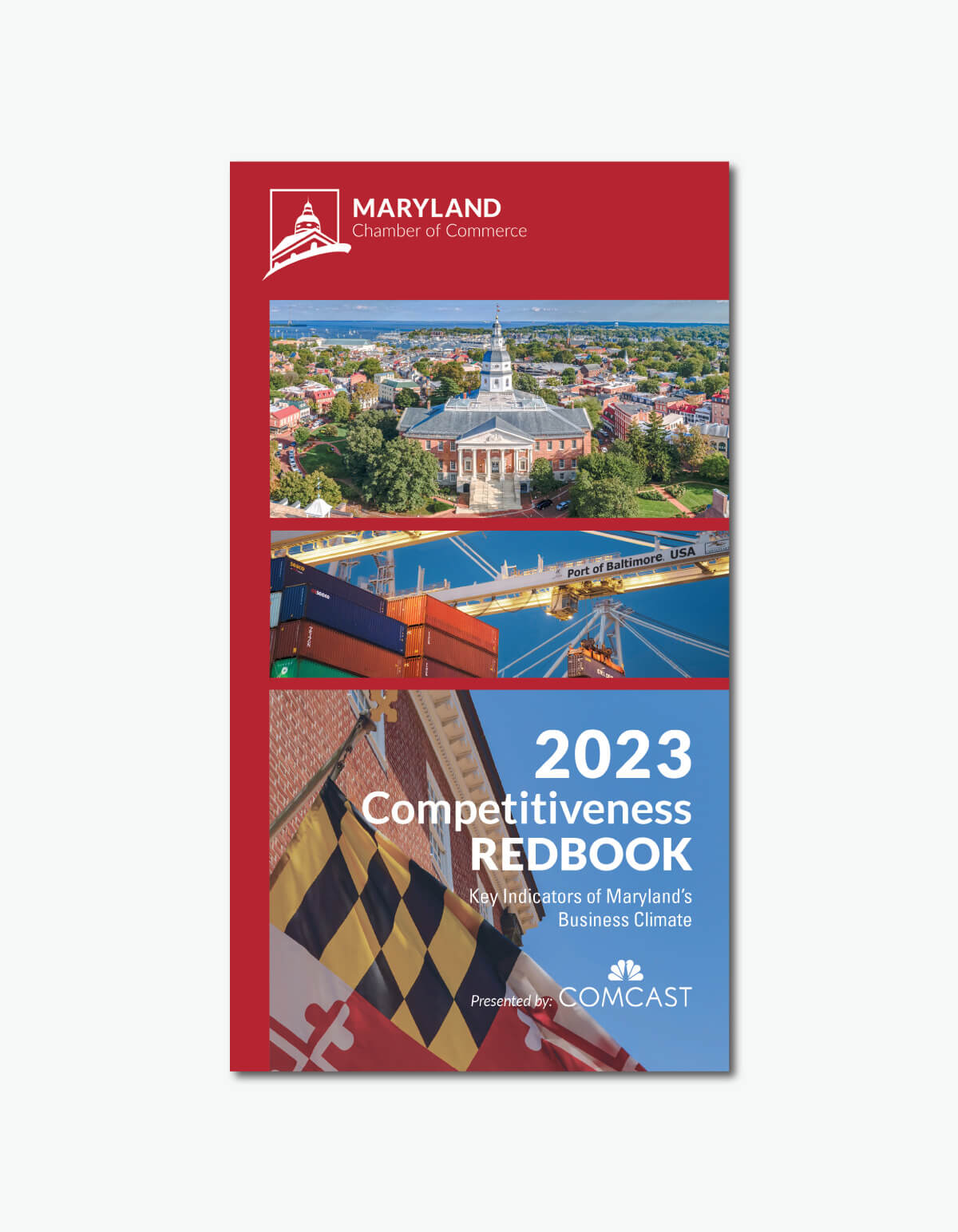Blog
Understanding Maryland’s Economic Competitiveness: Spotlight on Energy
Aug 1, 2023
The information provided below is based on data from our 2023 Competitiveness Redbook. Please check back soon for an updated analysis of our 2024 data.
Maryland faces energy cost challenges that could discourage investments and business growth. The state currently has some of the highest energy prices in the country, especially for industrial and residential consumers. As Maryland sets more ambitious renewable energy goals, production costs will likely rise further.
This combination of high prices and increasing costs raises concerns about business competitiveness and investment. However, with a clear understanding of the energy landscape, Maryland can make strategic decisions to support economic development while advancing environmental sustainability.
Economic Indicator Spotlight: Energy Costs, Resources and Regulations in Maryland
What the data is telling us:
Maryland’s energy prices are high, making it more expensive for businesses to operate and increasing the cost of living for residents.
The data: Maryland ranks 40th for the average retail price per kilowatt hour (kWh) for industrial customers, 31st for residential customers, and 23rd for commercial customers, with prices higher than neighboring states. Interestingly, according to the U.S. Energy Information Administration, Maryland’s industrial sector consumed 7% of the energy used in Maryland, and the sector consumed the least amount of energy per capita among the states.
Why it matters: Competitive energy costs are essential for attracting businesses and supporting a favorable business environment. Maryland’s high energy costs make it more expensive for businesses to operate and increase the cost of living for residents — and these issues factor into decisions to live, work, and/or operate a business in Maryland.
Maryland’s energy mix has strengths and weaknesses, but infrastructure, transmission and regulatory challenges drive up costs.
The data: Maryland’s energy mix in 2021 was dominated by nuclear and gas generation, with relatively lower contributions from coal, renewable sources, petroleum, and pumped storage, positioning the state favorably in terms of nuclear and pumped storage generation but lagging behind in renewable and coal generation. According to the U.S. Energy Information Administration, Maryland consumes about five times more energy than it produces.
Why it matters: Although Maryland’s reliance on nuclear energy and natural gas provide benefits in terms of energy reliability, stability and lower carbon emissions compared to other energy sources, infrastructure and transmission costs, high energy demand, the development of renewable energy infrastructure, and stringent, costly environmental regulations drive costs up for energy producers, and those costs are often passed on to businesses and consumers.
Maryland earned a below average rating for the state’s regulatory environment.
The data: Maryland’s regulatory environment — and the anticipation of a more restrictive regulatory climate to come — recently led to the state earning a “below average” rating from Regulatory Research Associates (RRA), a financial analyst group within S&P Global Commodity Insights. This moves Maryland, who previously held an “average” rating, to the bottom of the list when it comes to regulatory environments affecting the utility and energy sectors, with only three other states rated lower than Maryland.
Why it matters: This leaves Maryland at a significant disadvantage when compared to states with more favorable regulatory climates and is a signal that may very well lead energy and utility businesses and investors to decide against investing in Maryland.
Key Takeaways
In an increasingly competitive economy, businesses have options when deciding where to invest. Unsurprisingly, they are seeking out states that incentivize business investments and innovation, and that offer a supportive environment for business growth while maintaining necessary oversight.
Maryland’s high energy costs, ranking below national averages for industrial, commercial, and residential customers, can discourage businesses from operating or expanding in the state, impacting its competitiveness and cost of living for residents.
While Maryland’s energy mix is dominated by nuclear and gas generation, the state faces challenges in renewable and coal generation, with infrastructure, transmission, and regulatory issues driving up costs for energy producers, which are often passed on to businesses and consumers.
Maryland’s below-average rating for its regulatory environment in the energy and utility sectors puts the state at a disadvantage compared to states with more favorable climates, potentially deterring energy and utility businesses and investors from choosing Maryland as an investment destination.
Strategic decisions around energy policy and utility regulations will be needed to balance environmental protections with business competitiveness and consumer affordability.
Data Sources:
- U.S. Department of Energy, 2020-2021
- Regulatory Research Associates (RRA)
- U.S. Energy Information Administration
Additional Reading:
- Maryland State Profile and Energy Estimates (The U.S. Energy Information Administration, November 2022)
- National financial agency downgrades assessment of Md.’s utility regulation. What does it mean? (Maryland Matters, June 2023)




